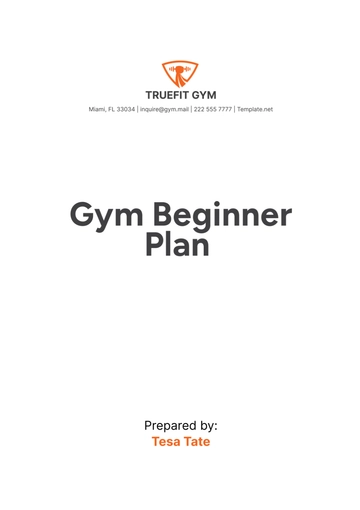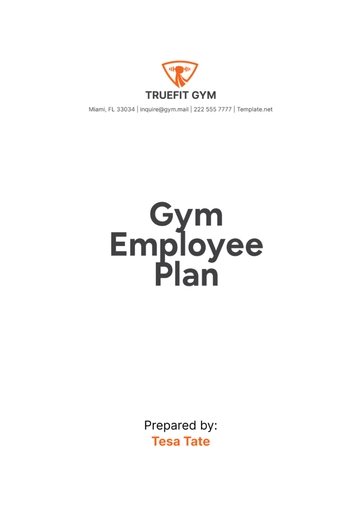Free Gym Strategy Plan

I. Executive Summary
This Gym Strategy Plan outlines the strategic objectives, initiatives, and actions necessary to achieve the long-term goals of [Your Company Name] Gym. It covers key areas such as market analysis, business operations, marketing strategies, financial planning, and performance evaluation. Our aim is to establish [Your Company Name] Gym as a leading fitness center, renowned for its exceptional services, innovative programs, and customer-centric approach.
A. Mission Statement
The mission of [Your Company Name] Gym is to provide a welcoming and inclusive environment where individuals of all fitness levels can achieve their health and wellness goals. We are committed to offering state-of-the-art facilities, expert guidance, and a supportive community to help our members lead healthier, happier lives.
B. Vision Statement
Our vision is to be the premier fitness destination in the community, recognized for our exceptional service, innovative fitness programs, and commitment to improving the health and well-being of our members. We strive to inspire positive lifestyle changes and foster a culture of fitness and wellness.
C. Core Values
Integrity: We uphold the highest standards of integrity in all our actions.
Excellence: We continually strive for excellence in our services and programs.
Inclusivity: We create an inclusive environment where everyone feels welcome and valued.
Innovation: We embrace innovation to stay ahead in the fitness industry.
Community: We foster a sense of community and support among our members.
D. Strategic Objectives
Expand Membership Base: Increase membership by 20% within the next year through targeted marketing and referral programs.
Enhance Member Experience: Continuously improve facilities and services to enhance the overall member experience.
Financial Growth: Achieve a 15% increase in revenue by diversifying revenue streams and optimizing operational efficiency.
Community Engagement: Strengthen community ties through partnerships, events, and wellness programs.
Innovation in Fitness Programs: Introduce innovative fitness programs and classes to meet the evolving needs of our members.
II. Market Analysis
A. Industry Overview
The fitness industry has seen significant growth over the past decade, driven by increasing awareness of the importance of health and wellness. The global fitness market is expected to continue its upward trajectory, with a compound annual growth rate (CAGR) of 5.6% from [Year] to [Year]. Key trends include the rise of digital fitness solutions, increased demand for personalized training, and a growing focus on holistic wellness.
B. Target Market
Our target market includes individuals of all ages who are interested in improving their fitness levels and overall health.
Demographic Analysis
Age: Primarily targeting individuals aged 18-45.
Gender: Both male and female, with tailored programs for each.
Income: Middle to upper-middle income brackets.
Location: Residents within a 10-mile radius of [Your Company Name] Gym.
Psychographic Analysis
Lifestyle: Health-conscious individuals who prioritize fitness and wellness.
Behavior: Regular gym-goers and those seeking to incorporate fitness into their daily routine.
Preferences: Preference for modern, well-equipped facilities and a variety of fitness classes.
C. Competitive Analysis
To understand our competitive landscape, we have identified key competitors and assessed their strengths and weaknesses.
Key Competitors
Gym A: Known for its extensive range of equipment and facilities.
Gym B: Popular for its group classes and community-focused approach.
Gym C: Offers low-cost memberships but lacks personalized services.
Competitive Advantage
[Your Company Name] Gym differentiates itself through:
State-of-the-Art Facilities: Our gym is equipped with the latest fitness technology and high-quality equipment.
Expert Staff: Certified trainers and nutritionists who provide personalized guidance.
Innovative Programs: Unique fitness classes and wellness programs not offered by competitors.
Member Experience: Emphasis on creating a supportive and engaging environment.
D. SWOT Analysis
Strengths | Weaknesses |
|---|---|
State-of-the-art facilities | High operational costs |
Experienced and certified staff | Limited initial brand recognition |
Diverse range of fitness programs | Dependence on local market |
Strong community focus | Higher membership fees compared to budget gyms |
Opportunities | Threats |
|---|---|
Growing demand for fitness and wellness | Economic downturns affecting discretionary spending |
Expansion into digital fitness solutions | Intense competition from established gyms |
Partnerships with local businesses | Changing fitness trends |
III. Business Operations
A. Facility Management
Location and Layout
[Your Company Name] Gym is strategically located in the heart of the city, easily accessible to our target market. The gym spans 15,000 square feet, featuring separate areas for cardio, strength training, group classes, and wellness services. The layout is designed to ensure a smooth flow of members, minimizing congestion and enhancing the workout experience.
Equipment and Amenities
Our gym is equipped with the latest fitness equipment from leading brands. Amenities include:
Cardio Machines: Treadmills, ellipticals, stationary bikes, and rowing machines.
Strength Training: Free weights, resistance machines, and functional training equipment.
Group Class Studios: Dedicated spaces for yoga, Pilates, spinning, and high-intensity interval training (HIIT).
Wellness Services: Massage therapy, nutrition counseling, and recovery zones.
Additional Amenities: Locker rooms with showers, a juice bar, and a lounge area.
B. Staffing Plan
Organizational Structure
Our organizational structure ensures efficient management and high-quality service delivery. Key positions include:
General Manager: Oversees overall operations and strategic planning.
Fitness Director: Manages fitness programs and trainer staff.
Marketing Manager: Develops and executes marketing strategies.
Member Services Manager: Ensures member satisfaction and handles inquiries.
Trainers and Instructors: Certified professionals providing training and classes.
Support Staff: Receptionists, maintenance, and housekeeping staff.
Staff Training and Development
We invest in continuous training and development to ensure our staff remains knowledgeable and motivated. This includes:
Onboarding Program: Comprehensive training for new hires covering gym operations, customer service, and fitness protocols.
Ongoing Education: Regular workshops and certifications to keep staff updated on the latest fitness trends and techniques.
Performance Reviews: Bi-annual reviews to assess performance, provide feedback, and identify areas for improvement.
C. Membership Plans
Pricing Strategy
Our membership plans are designed to offer flexibility and value, catering to different needs and budgets. We offer:
Basic Membership: Access to gym facilities during off-peak hours.
Standard Membership: Full access to all facilities and group classes.
Premium Membership: Includes personal training sessions, wellness services, and additional perks.
Membership Type | Monthly Fee | Inclusions |
|---|---|---|
Basic | $30 | Off-peak access |
Standard | $50 | Full access to facilities and classes |
Premium | $80 | Full access, personal training, wellness services |
Membership Benefits
Members of [Your Company Name] Gym enjoy a range of benefits, including:
Access to Modern Facilities: Use of all gym equipment and amenities.
Variety of Classes: Unlimited participation in group fitness classes.
Personalized Training: Customized workout plans and personal training sessions.
Wellness Programs: Access to nutrition counseling and wellness services.
Community Events: Invitations to exclusive workshops, seminars, and social events.
D. Health and Safety Policies
Hygiene Protocols
Maintaining a clean and hygienic environment is a top priority at [Your Company Name] Gym. Our protocols include:
Daily Cleaning: Thorough cleaning and sanitization of all equipment and surfaces.
Sanitization Stations: Hand sanitizers and disinfectant wipes available throughout the gym.
Member Guidelines: Encouraging members to wipe down equipment before and after use.
Emergency Procedures
We have established comprehensive emergency procedures to ensure the safety of our members and staff:
Emergency Training: Regular training for staff on emergency response and first aid.
Evacuation Plan: Clearly marked exits and evacuation routes.
Emergency Equipment: Automated external defibrillators (AEDs) and first aid kits are readily available.
IV. Marketing Strategies
A. Branding and Positioning
Brand Identity
[Your Company Name] Gym's brand identity is built on the principles of health, community, and innovation. Our logo, color scheme, and marketing materials reflect these values, creating a cohesive and recognizable brand image.
Unique Selling Proposition (USP)
Our USP is our commitment to providing a holistic fitness experience that goes beyond traditional gym offerings. We integrate cutting-edge technology, personalized services, and a strong community focus to deliver unparalleled value to our members.
B. Marketing Channels
Digital Marketing
Digital marketing is a core component of our strategy, allowing us to reach a wide audience and engage with potential members effectively.
a. Social Media
We leverage platforms such as Facebook, Instagram, and Twitter to promote our services, share fitness tips, and engage with our community. Regular posts, stories, and live sessions help us maintain an active online presence.
b. Website and SEO
Our website is optimized for user experience and search engines, ensuring potential members can easily find information about [Your Company Name] Gym. Key features include:
Interactive Class Schedule: Allowing members to book classes online.
Member Portal: Access to personal training plans, progress tracking, and payment management.
SEO Strategy: Utilizing relevant keywords, quality content, and backlinks to improve search engine rankings.
Traditional Marketing
Traditional marketing complements our digital efforts, targeting local audiences through various channels.
Print Media: We place advertisements in local newspapers, fitness magazines, and community newsletters to reach potential members.
Community Events: Hosting and participating in community events, health fairs, and charity runs to build brand awareness and establish a presence in the community.
C. Customer Acquisition and Retention
Lead Generation
To attract new members, we implement strategies such as:
Free Trials: Offering complimentary trial periods for potential members to experience our facilities and services.
Referral Programs: Encouraging existing members to refer friends and family, with incentives such as discounts or free personal training sessions.
Online Advertising: Utilizing Google Ads, social media ads, and sponsored content to drive traffic to our website and generate leads.
Membership Retention Programs
Keeping existing members engaged and satisfied is crucial for long-term success. Our retention strategies include:
Regular Check-Ins: Personal trainers and staff regularly check in with members to offer support and track progress.
Member Feedback: Conducting surveys and feedback sessions to understand member needs and make improvements.
Exclusive Events: Hosting members-only events, workshops, and challenges to foster a sense of community and belonging.
D. Partnerships and Collaborations
Local Businesses
Collaborating with local businesses such as health food stores, wellness centers, and sports shops to offer mutual benefits, such as cross-promotions, discounts for members, and co-hosted events.
Health and Wellness Experts
Partnering with nutritionists, physiotherapists, and wellness coaches to provide comprehensive services to our members, enhancing their fitness journey with professional guidance and support.
V. Financial Planning
A. Budgeting and Forecasting
Initial Investment
A detailed budget outlining the initial investment required to set up [Your Company Name] Gym, including costs for facility renovation, equipment purchase, marketing, and staff recruitment.
Expense Category | Estimated Cost |
|---|---|
Facility Renovation | $100,000 |
Equipment Purchase | $200,000 |
Marketing | $50,000 |
Staff Recruitment and Training | $30,000 |
Miscellaneous | $20,000 |
Total | $400,000 |
Operating Expenses
Estimating the monthly and annual operating expenses to ensure financial stability and profitability.
Expense Category | Monthly Cost | Annual Cost |
|---|---|---|
Rent | $10,000 | $120,000 |
Utilities | $2,000 | $24,000 |
Salaries and Wages | $25,000 | $300,000 |
Marketing | $5,000 | $60,000 |
Maintenance and Repairs | $3,000 | $36,000 |
Total | $45,000 | $540,000 |
B. Revenue Streams
Membership Fees
The primary source of revenue, is generated from various membership plans as outlined earlier.
Additional Services
Generating additional revenue through services such as personal training, group classes, wellness programs, and retail sales of fitness products and apparel.
Revenue Stream | Monthly Revenue | Annual Revenue |
|---|---|---|
Membership Fees | $50,000 | $600,000 |
Personal Training | $10,000 | $120,000 |
Group Classes | $5,000 | $60,000 |
Retail Sales | $3,000 | $36,000 |
Total | $68,000 | $816,000 |
C. Financial Projections
Monthly and Annual Projections
Forecasting monthly and annual revenues, expenses, and net profits to ensure financial goals are met.
Financial Metric | Monthly | Annual |
|---|---|---|
Total Revenue | $68,000 | $816,000 |
Total Expenses | $45,000 | $540,000 |
Net Profit | $23,000 | $276,000 |
Break-Even Analysis
Calculating the break-even point to determine when the gym will start generating profit.
Metric | Amount |
|---|---|
Fixed Costs (Annual) | $300,000 |
Variable Costs (Annual) | $240,000 |
Total Costs (Annual) | $540,000 |
Break-Even Point | 9 months |
D. Funding and Investment
Identifying potential sources of funding such as bank loans, investor funding, and grants to cover initial investment and operating costs.
Maintaining transparent and positive relationships with investors through regular updates, financial reports, and performance reviews.
VI. Performance Evaluation
A. Key Performance Indicators (KPIs)
Membership Growth: Tracking the number of new memberships, renewals, and cancellations to gauge growth and retention.
Revenue Targets: Setting monthly and annual revenue targets and monitoring progress to ensure financial objectives are met.
KPI | Target | Actual |
|---|---|---|
New Memberships (Monthly) | 50 | [Number] |
Membership Renewals (Monthly) | 45 | |
Monthly Revenue | $68,000 |
B. Monitoring and Reporting
Monthly Reports: Preparing detailed monthly reports covering financial performance, membership statistics, and operational metrics to assess progress and identify areas for improvement.
Quarterly Reviews: Conducting comprehensive quarterly reviews to evaluate overall performance, adjust strategies, and set new targets.
C. Continuous Improvement
Feedback Mechanisms: Implementing mechanisms such as member surveys, suggestion boxes, and one-on-one meetings to gather feedback and make necessary adjustments to services and operations.
Adaptation and Innovation: Regularly reviewing and updating fitness programs, equipment, and facilities to ensure they meet the evolving needs and preferences of members. Encouraging staff to suggest and implement innovative ideas to enhance the member experience and stay ahead in the competitive market.
VII. Staffing and Training
A. Recruitment and Hiring
[Your Company Name] Gym aims to attract top talent through a comprehensive recruitment strategy. This strategy involves advertising job openings on various platforms, including job boards, social media, and the company website. Additionally, partnerships with local fitness schools and universities will be established to source qualified candidates. The recruitment process includes multiple stages: application screening, initial interviews, practical skill assessments, and final interviews.
Job Roles and Responsibilities
Clearly defining job roles and responsibilities ensures that each staff member understands their duties and how they contribute to the overall success of the gym. Key positions include:
General Manager: Oversees all gym operations, including financial management, staff supervision, and strategic planning.
Fitness Instructors: Conduct group classes, create workout plans, and provide personal training sessions.
Front Desk Staff: Handle member check-ins, manage membership sales, and provide customer service.
Maintenance Staff: Ensure the cleanliness and functionality of the gym equipment and facilities.
Each role is outlined in detailed job descriptions, which specify qualifications, responsibilities, and performance expectations.
B. Training and Development
Initial Training Program
Upon hiring, all new employees undergo a comprehensive initial training program. This program includes orientation sessions to familiarize them with [Your Company Name] Gym’s policies, procedures, and culture. Training modules cover customer service, sales techniques, fitness instruction, and equipment usage. New hires also receive hands-on training and shadow experienced staff members.
Ongoing Professional Development
Continuous professional development is crucial for maintaining high standards and ensuring staff stay updated with industry trends. Regular workshops, seminars, and certification courses are organized for all employees. Additionally, employees are encouraged to attend external training programs and conferences to broaden their knowledge and skills.
C. Performance Management
Performance Evaluation System
A structured performance evaluation system is implemented to assess staff performance regularly. This system includes monthly check-ins, quarterly reviews, and annual appraisals. Performance metrics such as member feedback, sales targets, class attendance, and adherence to gym protocols are used to evaluate staff performance.
Reward and Recognition
To motivate and retain top performers, [Your Company Name] Gym has a robust reward and recognition program. Employees who consistently perform well are eligible for bonuses, promotions, and other incentives. Additionally, an employee of the month program highlights and rewards exceptional contributions.
VIII. Facilities and Equipment
A. Facility Layout and Design
Gym Layout
The layout of [Your Company Name] Gym is designed to optimize space and enhance the member experience. The facility includes distinct zones for different activities, such as cardio, strength training, group classes, and relaxation. This zoning helps in managing crowd flow and ensuring each member has access to the equipment and space they need.
Interior Design
The interior design of the gym reflects a modern and welcoming atmosphere. Using high-quality materials, adequate lighting, and motivating décor, the gym environment aims to inspire members and create a pleasant workout experience. Comfortable seating areas and well-maintained locker rooms further enhance the member experience.
B. Equipment and Maintenance
Equipment Selection
Selecting the right equipment is essential for catering to diverse member needs. [Your Company Name] Gym invests in high-quality, durable fitness equipment from reputable brands. The selection includes a mix of cardiovascular machines, strength training equipment, free weights, and specialized machines to support various workout routines.
Maintenance Protocols
Regular maintenance is crucial to ensure the safety and functionality of gym equipment. A maintenance schedule is established, with daily, weekly, and monthly checks performed by trained staff. Any equipment issues are promptly addressed to minimize downtime and prevent accidents.
C. Health and Safety
Health and Safety Standards
[Your Company Name] Gym is committed to maintaining high health and safety standards. Compliance with local health regulations and industry best practices is ensured. Regular audits and inspections are conducted to identify potential hazards and implement corrective measures.
Emergency Procedures
Comprehensive emergency procedures are in place to handle situations such as injuries, medical emergencies, and natural disasters. Staff are trained in first aid and CPR, and emergency equipment such as defibrillators and first aid kits are readily available. Clear evacuation routes and procedures are communicated to all members and staff.
IX. Member Services and Experience
A. Customer Service Excellence
Member Interaction
Exceptional customer service is a cornerstone of [Your Company Name] Gym’s member experience. Staff are trained to engage with members courteously and professionally. Personalized service, such as remembering member names and preferences, enhances the overall experience and fosters a sense of community.
Member Feedback
Regularly soliciting member feedback helps us understand their needs and improve our services. Feedback channels include suggestion boxes, online surveys, and face-to-face interactions. All feedback is reviewed, and actionable insights are implemented promptly.
B. Additional Member Services
Personal Training
Offering personalized training programs tailored to individual member goals is a key service at [Your Company Name] Gym. Certified personal trainers work closely with members to create customized workout plans, provide motivation, and track progress.
Nutritional Guidance
Providing nutritional guidance complements our fitness services. In-house nutritionists offer consultations, meal planning, and dietary advice to help members achieve their health and fitness goals. Workshops and seminars on nutrition are also regularly organized.
C. Community Building
Member Events
Organizing regular member events such as fitness challenges, social gatherings, and educational workshops fosters a strong sense of community. These events provide opportunities for members to connect, share experiences, and support each other in their fitness journeys.
Online Community
Creating an online community through social media platforms and member portals extends our community engagement beyond the gym walls. Members can share their progress, participate in online challenges, and access exclusive content such as workout tips and nutritional advice.
X. Conclusion
A. Implementation and Monitoring
Implementing the strategies outlined in this plan requires a collaborative effort from all team members. A detailed implementation schedule will be developed to ensure the timely execution of each strategic initiative. Regular monitoring and evaluation will be conducted to assess progress and make necessary adjustments. Key performance indicators (KPIs) and regular reports will be used to track the effectiveness of our strategies and ensure we are meeting our objectives.
B. Future Growth and Expansion
[Your Company Name] Gym is committed to continuous improvement and growth. As we establish a strong presence in the local market, we will explore opportunities for expansion, including opening additional locations and introducing new services. Our focus on innovation and member satisfaction will drive our long-term success and position us as a leader in the fitness industry.
C. Commitment to Excellence
At [Your Company Name] Gym, our commitment to excellence is unwavering. We strive to provide the highest quality fitness experience, foster a supportive community, and help our members achieve their health and wellness goals. This strategy plan serves as a roadmap to guide our efforts and ensure we stay true to our mission and vision.
- 100% Customizable, free editor
- Access 1 Million+ Templates, photo’s & graphics
- Download or share as a template
- Click and replace photos, graphics, text, backgrounds
- Resize, crop, AI write & more
- Access advanced editor
Outline strategic objectives with Template.net's customizable and editable Gym Strategy Plan Template. Personalize plans using the AI Editor Tool to meet your gym's needs. Ensure clear and professional strategy documentation, enhancing long-term planning and success with this comprehensive and user-friendly template.
You may also like
- Finance Plan
- Construction Plan
- Sales Plan
- Development Plan
- Career Plan
- Budget Plan
- HR Plan
- Education Plan
- Transition Plan
- Work Plan
- Training Plan
- Communication Plan
- Operation Plan
- Health And Safety Plan
- Strategy Plan
- Professional Development Plan
- Advertising Plan
- Risk Management Plan
- Restaurant Plan
- School Plan
- Nursing Home Patient Care Plan
- Nursing Care Plan
- Plan Event
- Startup Plan
- Social Media Plan
- Staffing Plan
- Annual Plan
- Content Plan
- Payment Plan
- Implementation Plan
- Hotel Plan
- Workout Plan
- Accounting Plan
- Campaign Plan
- Essay Plan
- 30 60 90 Day Plan
- Research Plan
- Recruitment Plan
- 90 Day Plan
- Quarterly Plan
- Emergency Plan
- 5 Year Plan
- Gym Plan
- Personal Plan
- IT and Software Plan
- Treatment Plan
- Real Estate Plan
- Law Firm Plan
- Healthcare Plan
- Improvement Plan
- Media Plan
- 5 Year Business Plan
- Learning Plan
- Marketing Campaign Plan
- Travel Agency Plan
- Cleaning Services Plan
- Interior Design Plan
- Performance Plan
- PR Plan
- Birth Plan
- Life Plan
- SEO Plan
- Disaster Recovery Plan
- Continuity Plan
- Launch Plan
- Legal Plan
- Behavior Plan
- Performance Improvement Plan
- Salon Plan
- Security Plan
- Security Management Plan
- Employee Development Plan
- Quality Plan
- Service Improvement Plan
- Growth Plan
- Incident Response Plan
- Basketball Plan
- Emergency Action Plan
- Product Launch Plan
- Spa Plan
- Employee Training Plan
- Data Analysis Plan
- Employee Action Plan
- Territory Plan
- Audit Plan
- Classroom Plan
- Activity Plan
- Parenting Plan
- Care Plan
- Project Execution Plan
- Exercise Plan
- Internship Plan
- Software Development Plan
- Continuous Improvement Plan
- Leave Plan
- 90 Day Sales Plan
- Advertising Agency Plan
- Employee Transition Plan
- Smart Action Plan
- Workplace Safety Plan
- Behavior Change Plan
- Contingency Plan
- Continuity of Operations Plan
- Health Plan
- Quality Control Plan
- Self Plan
- Sports Development Plan
- Change Management Plan
- Ecommerce Plan
- Personal Financial Plan
- Process Improvement Plan
- 30-60-90 Day Sales Plan
- Crisis Management Plan
- Engagement Plan
- Execution Plan
- Pandemic Plan
- Quality Assurance Plan
- Service Continuity Plan
- Agile Project Plan
- Fundraising Plan
- Job Transition Plan
- Asset Maintenance Plan
- Maintenance Plan
- Software Test Plan
- Staff Training and Development Plan
- 3 Year Plan
- Brand Activation Plan
- Release Plan
- Resource Plan
- Risk Mitigation Plan
- Teacher Plan
- 30 60 90 Day Plan for New Manager
- Food Safety Plan
- Food Truck Plan
- Hiring Plan
- Quality Management Plan
- Wellness Plan
- Behavior Intervention Plan
- Bonus Plan
- Investment Plan
- Maternity Leave Plan
- Pandemic Response Plan
- Succession Planning
- Coaching Plan
- Configuration Management Plan
- Remote Work Plan
- Self Care Plan
- Teaching Plan
- 100-Day Plan
- HACCP Plan
- Student Plan
- Sustainability Plan
- 30 60 90 Day Plan for Interview
- Access Plan
- Site Specific Safety Plan













